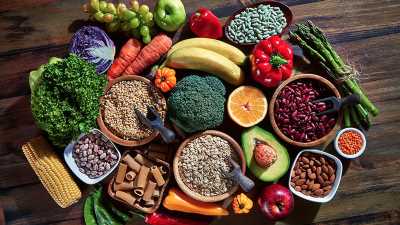Portfolio Diet Tied to Lower Risk for CVD, Stroke
TOPLINE:
Close adherence to the Portfolio dietary pattern, including foods that have been shown to actively lower cholesterol (eg, plant proteins, nuts, viscous fiber, phytosterols and plant monounsaturated fats) is associated with a 14% lower risk for total cardiovascular disease (CVD), coronary heart disease (CHD), and stroke, pooled results from three large observational studies suggest.
METHODOLOGY:
The study included 73,924 women from the Nurses’ Health Study (NHS), 92,346 women from the Nurses’ Health Study II (NHSII), and 43,970 men from the Health Professionals Follow-Up Study (HPFS) without CVD at baseline who were followed biennially on lifestyle, medical history, and other health-related factors.
From food-frequency questionnaires (FFQs) completed every 4 years, researchers categorized foods into the six components of the Portfolio diet:
Plant protein such as legumes, beans, tofu, peas, and soymilk
Nuts and seeds
Fiber sources such as bran, oats, berries, and eggplant
Phytosterols
Monounsaturated fat (MUFA) sources such as olive oil and avocado
High saturated fat and cholesterol sources such as whole-fat dairy and red and processed meats
They scored each from 1 (least adherent) to 5 (most adherent), with a higher score indicating higher consumption.
Researchers examined the association of this Portfolio Diet Score (PDS) with total CVD, CHD, and stroke, in the three cohorts, and associations with plasma levels of lipid and inflammatory biomarkers in a subpopulation of the cohorts.
During up to 30 years of follow-up, there were 16,917 incident CVD cases, including 10,666 CHD cases and 6473 strokes.
In a pooled analysis of the three cohorts, the fully adjusted hazard ratio (HR) for total CVD comparing the highest with the lowest quintile of the PDS was 0.86 (95% CI, 0.81 – 0.92; P for trend < .001).
Also comparing extreme quintiles, the pooled HR for CHD was 0.86 (95% CI, 0.80 – 0.93; P for trend = .0001) and for stroke, it was 0.86 (95% CI, 0.78 – 0.95; P for trend = .0003).
A higher PDS was also associated with a more favorable lipid profile and lower levels of inflammation.
TAKEAWAY:
IN PRACTICE:
“This study provides additional evidence to support the use of the plant-based Portfolio dietary pattern for reducing the risk of CVD,” which aligns with American Heart Association guidelines promoting consumption of whole grains, fruits and vegetables, plant-based proteins, minimally processed foods, and healthy unsaturated plant oils, the authors conclude.
SOURCE:
The study was conducted by Andrea J. Glenn, PhD, RD, Department of Nutrition, Harvard T.H. Chan School of Public Health, Boston, and colleagues. It was published online October 25 in the journal Circulation.
LIMITATIONS:
As the study was observational, residual confounding can’t be ruled out. Diet was self-reported, which may have resulted in measurement errors. Consumption of some recommended foods was low, even in the top quintiles, so the association with CVD risk may be underestimated. Information on a few key Portfolio diet foods, including barley and okra, was unavailable, potentially leading to underestimation of intake, which may also attenuate the findings.
DISCLOSURES:
The study was supported by the Diabetes Canada End Diabetes 100 Award. The NH and HPFS studies are supported by the National Institutes of Health. Glenn is supported by a Canadian Institutes of Health Research fellowship; she has received honoraria or travel support from the Soy Nutrition Institute Global, Vinasoy, and the Academy of Nutrition and Dietetics. See original article for disclosures of other authors.
For more from theheart.org | Medscape Cardiology, join us on X (formerly Twitter) and Facebook
Source: Read Full Article
